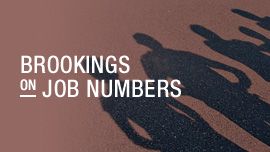The pace of employment gains slowed in January from the torrid pace of the previous three months. The latest BLS jobs report shows that employers added 151,000 to their payrolls in January, well below monthly gains in October through December. In that quarter payrolls climbed almost 280,000 a month. For two reasons, the deceleration in employment gains was not a complete surprise. First, the rapid growth payrolls in the last quarter did not seem consistent with other indicators of growth in the quarter. Preliminary GDP estimates suggest that output growth slowed sharply in the fourth quarter compared with the previous two. Second, I see few indicators suggesting the pace of economic growth has picked up so far this year.
It’s worth noting that employment gains in January were far faster than needed to keep the unemployment rate from increasing. In fact, if payrolls continue to grow at January’s pace throughout the year, we should expect the unemployment rate to continue falling. As usual in the current expansion, private employers accounted for all of January’s employment gains. Government payrolls shrank slightly. The number of public employees is about the same as it was last July. Over the same period, private employers added about 213,000 workers a month to their payrolls. In January employment gains slowed in construction and in business and professional industries. Payrolls shrank in mining. Since mining payrolls reached a peak in September 2014, they have fallen 16 percent. Manufacturing payrolls rose slightly in January, but payroll gains have been very slow over the past year. Employment in the temporary help industry contracted in January. The industry has seen no net change in payrolls since October.
Average hourly pay in private companies edged up in January. The average nominal wage was 2.5 percent higher than its level 12 months earlier. This is a faster rate of improvement compared with what we saw earlier in the recovery, when annual pay gains averaged about 2.0 percent a year. The modest acceleration in nominal pay gains has occurred against the backdrop of slowing consumer price inflation. The combination has given workers real wage gains approaching 2.0 percent over the past year.
The BLS household survey showed a small drop in unemployment. The jobless rate fell to 4.9 percent, just 0.3 points above its average level in 2007, the last year before the Great Recession. The drop in unemployment was the result of a rise in the number of survey respondents who were employed. The labor force participation rate increased in January, and it has increased 0.3 points since October.
This rebound in labor force participation is modest compared with the drop that occurred between 2008 and 2015. From 2007 to January 2016 the adult participation rate fell 3.4 percentage points. Roughly half the drop is traceable to population aging, but the other half is due to factors related to the deep slump or to long-term factors that have affected Americans’ willingness to enter or remain in the workforce. If we assume all of the drop was due to factors that have temporarily discouraged jobless adults from seeking work, then we can recalculate the unemployment rate to reflect the rate we would see if all of these discouraged workers were reclassified as unemployed. That calculation suggests the current unemployment rate would be about 7.4 percent rather than 4.9 percent.
It is of course unlikely all the adults who’ve dropped out the labor force would stream back in if job finding got easier and real wages continued to rise. It is encouraging to see, however, that participation is now climbing after a long period of decline. Over the past four months, the labor force participation rate of 25-54 year-olds increased 0.5 percentage points.
The Brookings Institution is committed to quality, independence, and impact.
We are supported by a diverse array of funders. In line with our values and policies, each Brookings publication represents the sole views of its author(s).




Commentary
Job gains slow in January, but signs of a rebound in labor force participation
February 5, 2016